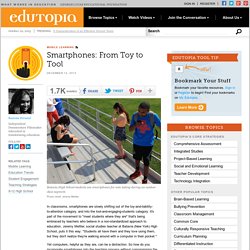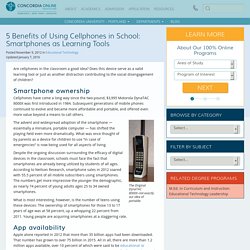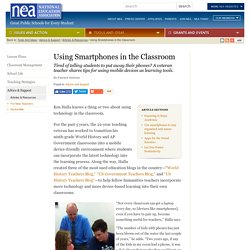

Do mobile devices in the classroom really improve learning outcomes? Mobile devices as teaching tools are becoming a more and more common part of the American education experience in classrooms, from preschool through graduate school.

A recent Pew Research Center survey found that 58% of U.S. teachers own smartphones — 10 percentage points higher than the national average for adults. Those teachers are building that tech-savviness into their lesson plans, too, by embracing bring-your-own-device policies and leading the push for an iPad for every student. In 2013, an estimated 25% of U.S. schools had BYOD policies in place and it’s reasonable to assume those numbers have risen in the past two years.
What do these mobile devices really add, though? Is there more to this tech trend than just grabbing the attention of students? Research finds benefits of mobile technology That same Pew Research Center survey asked a group of Advanced Placement and National Writing Project teachers about the educational impact of Internet technology in the classroom. Smartphones: From Toy to Tool. In classrooms, smartphones are slowly shifting out of the toy-and-liability-to-attention category, and into the tool-and-engaging-students category.

It's part of the movement to "meet students where they are" that's being embraced by teachers who believe in a non-standardized approach to education. Jeremy Mettler, social studies teacher at Batavia (New York) High School, puts it this way: "Students all have them and they love using them, but they don't realize they're walking around with a computer in their pocket. " Yet computers, helpful as they are, can be a distraction. So how do you incorporate smartphones into the teaching process without compromising the learning process? I talked to a number of teachers around the country to see how they're addressing this challenge.
A Powerful Participation Tool Mettler finds smartphones helpful to encourage participation in class. Example Batavia High School students use smartphones for note taking during an outdoor class segment. Keeping the Focus. How to Use Cell Phones as Learning Tools. Does your staff need Educational Technology training?

The K-12 Teachers Alliance can help you plan your in-service professional development at no additional cost. Regardless of your school’s cell phone policy, the reality in most schools is that students have phones in their pockets, purses, or hoodies. Why not get these tools out in plain sight and use them for good and not evil? Here are some easy to use strategies to use cell phones in the classrooms. Proven teaching strategies to boost your students' happiness. A few suggestions.on classroom activities that involve performance for... We point out some knowledgeable educators who quickly can become your trusted... Should We Allow Cell Phones in School? Benefits of Smartphones.
Are cellphones in the classroom a good idea?

Does this device serve as a valid learning tool or just as another distraction contributing to the social disengagement of children? Smartphone ownership Cellphones have come a long way since the two-pound, $3,995 Motorola DynaTAC 8000X was first introduced in 1984. Subsequent generations of mobile phones continued to evolve and became more affordable and portable, and offered even more value beyond a means to call others. The Original DynaTAC 8000X–not exactly our idea of portable. The advent and widespread adoption of the smartphone — essentially a miniature, portable computer — has shifted the playing field even more dramatically. Despite the ongoing discussion surrounding the efficacy of digital devices in the classroom, schools must face the fact that smartphones are already being utilized by students of all ages.
App availability Apple alone reported in 2012 that more than 35 billion apps had been downloaded. Share on Pinterest. Using Mobile Devices to Enhance Student Learning. 10. Using Smartphones in the Classroom. By Edward Graham Found in: Advice and Support Ken Halla knows a thing or two about using technology in the classroom.

For the past 5 years, the 22-year teaching veteran has worked to transition his ninth-grade World History and AP Government classrooms into a mobile device-friendly environment where students can incorporate the latest technology into the learning process. Along the way, Halla created three of the most used education blogs in the country—“World History Teachers Blog,” “US Government Teachers Blog,” and “US History Teachers Blog”—to help fellow humanities teachers incorporate more technology and more device-based learning into their own classrooms.
“Not every classroom can get a laptop every day, so [devices like smartphones], even if you have to pair up, become something useful for teachers,” Halla says. “The number of kids with phones has just been blown out of the water the last couple of years,” he adds. Ensuring it stays academic. Mobile Devices in Teaching and Learning. Smartphones as Tools for Education - eCycle Best. Introduction The smartphone owner population is growing. Multi-functionality, portability, and connectivity are opening doors for learning. No wonder students harness smartphone technology to help them in education. These tiny pocket computers keep students connected to the Internet, improving their academics. However, many students are oblivious to the power in their hands; the power of educational apps, the potential for success.
What Is a Smartphone? On a superficial level, a smartphone is a gadget that allows people to make phone calls as well as use other features (which used to be found only on personal digital assistants or personal computers) that are not common on a conventional phone. Before there were smartphones, there were only cell phones and personal digital assistants (PDAs). The first, most successful smartphone was the BlackBerry. Smartphones have become part of contemporary culture.